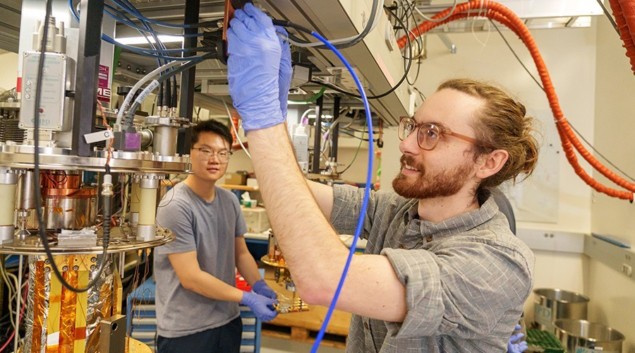
Sound is very much a part of the classical, macroscopic world – so we normally do not think of sound as a quantum phenomenon. However, for some of the quietest sounds possible, quantum mechanics kicks in. Now, a team of researchers at the Pritzker School of Molecular Engineering at the University of Chicago and the US’s Argonne National Lab have shown how sound can be used to create two quintessentially quantum effects: superposition and interference. As a result, sound-based technologies could soon be used to create quantum computers.
Just as electromagnetic waves are quantized as particle-like photons, sound waves can be quantized as particle-like phonons. However, unlike photons, which are fundamental particles, phonons are collective excitations that involve large numbers of atoms or molecules. Nevertheless, these collective excitations obey the laws of quantum mechanics. Now, Chicago’s Andrew Cleland and colleagues have shown that the quantum nature of phonons could potentially be used to perform complex computational tasks.
â€Å�A phonon represents the collective motion of an astronomical number of atoms,†Cleland says. â€Å�And they all have to work together in order to obey quantum mechanics. There was this question in the back of my mind, will this really work? We tried it, and it’s kind of amazing, but it really does work.â€Â
Splitting a phonon
The team created single phonons as propagating wavepackets on the surface of a lithium niobate chip. The phonons were created and detected using two superconducting qubits, which were located on a separate chip, and coupled to the lithium niobate chip through the air. The two superconducting qubits were located either of the chip, with a two-millimetre-long channel between them hosting the travelling phonons.
In the middle of the phonon’s path, the team created a beamsplitter, which is a device that splits a beam of phonons into two beams travelling in two different directions. Because of the quantum nature of phonons, the beamsplitter can put a phonon into a quantum superposition of a phonon that took one path and a phonon that took the other path. The team demonstrated their ability to create such a superposition by sending both �halves†back through the beamsplitter and observing an interference pattern.
Next, they turned their attention to reproducing the â€Å�Hong-Ou-Mandel effectâ€Â, which lies at the heart of photonic quantum computing architectures. Normally, this involves sending two photons into a beam splitter from opposite directions. Quantum interference dictates that both of photons will always emerge in the same direction from the beamsplitter. The Chicago group was able to demonstrate this effect using phonons.
A new tool
Quantum computers are currently being developed using several different types of qubits, including trapped ions, superconducting circuits and photons. Unlike ions and superconductors, photons do not interact with each other – two light beams can just pass through each other unaffected. This means that it is difficult to perform two-qubit operations with photons. Instead, photonic platforms create large clusters of highly entangled photons, and use classical measurement of some of those photons to perform computations.
Because of their similarity to photons, phonons are expected to be capable of the same types of quantum information processing as photons, and Cleland and colleagues have shown that this should be possible. However, phonons do differ from photons in several key ways. Phonon qubits require cryogenic cooling and suffer from much higher loss rates. Nevertheless, this platform offers an important advantage that traditional photonic implementations do not: the phonon state is detected by a superconducting qubit in a fully quantum way, preserving all the superposition and entanglement information. The researchers hope that this will prove useful in the development of future quantum technologies.
â€Å�We’re trying to put it out there,†Cleland says, â€Å�that you can build a system where you can optical-style quantum computing on a small system and you could integrate that directly with a standard gate-based quantum computerâ€Â. Cleland explains that this is important because this direct integration cannot be done with photons.
Others agree that this has potential. �Part of the appeal of investigating these platforms with phonons is that they could potentially allow you to do conversion between microwaves and visible light and that is definitely very exciting,†says Nicolás Quesada, who is an expert in photonic quantum information at Polytechnique Montréal and who was not involved in the research.
The research is described in Science.

